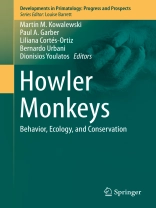Howler monkeys (genus Alouatta) comprise twelve species of leaf-eating New World monkeys that range from southern Mexico through northern Argentina. This genus is the most widespread of any New World primate taxa, and can be found to inhabit a range of forest types from undisturbed rainforest to severely anthropogenically impacted forest fragments. Although there have been many studies on individual species of howler monkeys, this book is the first comprehensive volume to place information on howler behavior and biology within a theoretical framework of ecological and social adaptability. This is the second of two volumes devoted to the genus Alouatta.
This volume:
· Examines behavioral and physiological mechanisms that enable howler monkeys to exploit highly disturbed and fragmented habitats
· Presents models of howler monkey diet, social organization, and mating systems that can also inform researchers studying Old World colobines, apes, and other tropical mammals
These goals are achieved in a collection of chapters written by a distinguished group of scientists on the feeding ecology, behavior, mating strategies, and management and conservation of howlers. This book also contains chapters on the howler microbiome, the concept of behavioral variability, sexual selection, and the role of primates in forest regeneration.
विषयसूची
PART 1. INTRODUCTION.- Chapter 1. Why is it Important to Continue Studying the Behavioral Ecology and Conservation Management of Howler Monkeys?.- PART 2: BEHAVIORAL ECOLOGY.- Chapter 2. Diets of Howler Monkeys.- Chapter 3. Insights into Reproductive Strategies and Sexual Selection in Howler Monkeys.- Chapter 4. Evidence of Alternative Dietary Syndromes and Nutritional Goals in the Genus
Alouatta.- Chapter 5. Seed Dispersal by Howler Monkeys: Current Knowledge, Conservation Implications, and Future Directions.- Chapter 6. Interactions of Howler Monkeys with Other Vertebrates: A Review.- Chapter 7. Solving the Collective Action Problem During Intergroup Encounters: The Case of Black and Gold Howler Monkeys.- Chapter 8. Howler Monkey Positional Behavior.- Chapter 9. Ranging Behavior and Spatial Cognition of Howler Monkeys.- PART 3: CONSERVATION AND MANAGEMENT.- Chapter 10. The Ethnoprimatology of Howler Monkeys (
Alouatta spp.): From Past to Present.- Chapter 11. Anthropogenic Habitat Modification, Tourist Interactions and Crop-Raiding in Howler Monkeys.- Chapter 12. Health and Welfare of Howler Monkeys in Captivity
.-
Chapter 13. Fruit as a Key Factor in Howler Monkey Population Density: Conservation Implications. Chapter 14. Conservation of
Alouatta: Social and Economic Drivers of Habitat Loss, Information Vacuum and Mitigating Population Declines.- PART 4: CONCLUSION.- Chapter 15. New Challenges in the Study of Howler Monkey Behavioral Ecology and Conservation: Where we are and where we need to go?.












